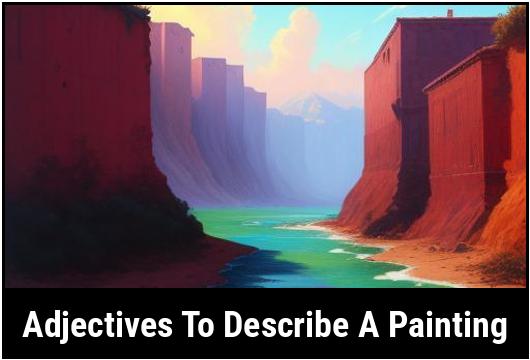- You are here:
- Home »
- adjectives
- » 31 Adjectives To Describe A Painting

31 Adjectives To Describe A Painting
Paintings are a unique form of art that combine color, composition, and emotion to create a visual experience. Describing a painting can be a challenging but rewarding endeavor as it allows one to delve into the nuances of the artist’s work and convey its essence to others. Adjectives play a crucial role in this process, enabling individuals to articulate the complex and subtle qualities of a painting. This article explores the use of adjectives to describe paintings, how to choose the right adjectives, and the types of adjectives best suited for this purpose.
Key Takeaways
- Adjectives are essential for painting description as they help convey the visual, emotional, and conceptual aspects of the artwork.
- When selecting adjectives for painting description, consider the mood, technique, subject matter, and overall impression the painting evokes.
- Types of adjectives for painting description include visual, emotional, conceptual, and technical descriptors.
- Using a variety of adjectives can enrich the description and provide a comprehensive understanding of the painting.
Adjectives To Describe A Painting
1. Captivating:
A captivating painting has the ability to hold our attention, drawing us in with its compelling subject matter or intricate details. It grabs our gaze and keeps us enraptured, almost as if we are under a spell.
2. Vibrant:
Vibrant paintings are like a burst of energy, radiating colors that are rich and intense. They exude brightness and liveliness, making them visually stimulating and full of life.
3. Serene:
A serene painting creates a sense of calm and tranquility. It often features calming hues, gentle brushstrokes, or peaceful subject matters, providing a soothing visual experience.
4. Mysterious:
Mysterious paintings leave us with a sense of intrigue and curiosity, as if they hold secrets waiting to be unraveled. They often feature hidden meanings, ambiguous elements, or enigmatic subjects.
5. Whimsical:
Whimsical paintings have an element of playfulness and imagination. They transport us to a world of fantasy and often feature elements that defy logic, bringing a sense of joy and wonder.
6. Dynamic:
Dynamic paintings possess a sense of movement and energy. They captivate with brushstrokes or lines that create a sense of action, making the subjects appear alive and in motion.
7. Harmonious:
Harmonious paintings have a pleasing combination of elements such as colors, shapes, and composition. They create a sense of balance and unity, evoking a feeling of aesthetic completeness.
8. Ethereal:
Ethereal paintings are delicate and otherworldly, almost appearing as if they exist in a dream-like realm. They often feature soft colors, diffused light, and ethereal subjects, leaving us with a feeling of enchantment.
9. Majestic:
Majestic paintings evoke a sense of grandeur and power. They showcase subjects that are imposing or awe-inspiring, whether it’s a majestic landscape or a regal figure.
10. Provocative:
Provocative paintings challenge our perceptions and evoke strong emotions. They may depict controversial subjects, evoke introspection, or critique societal norms, leaving a lasting impact on the viewer.
11. Intricate:
Intricate paintings showcase an impressive level of detail. They often require closer inspection to fully appreciate the meticulous brushwork or complex composition, offering a feast for the eyes.
12. Tranquil:
A tranquil painting exudes peace and calmness. It often features serene landscapes or tranquil scenes, inducing a sense of relaxation and serenity in the viewer.
13. Expressive:
Expressive paintings are a reflection of the artist’s emotions and thoughts. They convey a strong message or evoke a particular mood through powerful brushstrokes or vivid colors.
14. Awe-inspiring:
Awe-inspiring paintings leave us in awe and admiration. They possess a sense of greatness or extraordinary beauty, often showcasing vast landscapes or breathtaking natural phenomena.
15. Playful:
Playful paintings have a sense of joy and lightheartedness. They often feature whimsical characters or scenes that bring a smile to our faces, invoking a sense of childlike wonder.
16. Bold:
Bold paintings demand attention and make a strong statement. They feature confident brushstrokes, vivid colors, or daring subject matters, standing out with their fearless approach.
17. Melancholic:
Melancholic paintings evoke a feeling of sadness or nostalgia. They often depict somber, introspective subjects or scenes, leaving the viewer with a sense of bittersweet emotions.
18. Enchanting:
Enchanting paintings have a magical quality, captivating us with their beauty and charm. They often showcase fantastical scenes or ethereal characters, transporting us to a world of wonder.
19. Mesmerizing:
Mesmerizing paintings have a hypnotic effect on the viewer. They possess a certain allure and fascination, drawing us in with their intricate patterns, optical illusions, or mesmerizing textures.
20. Timeless:
Timeless paintings transcend the limitations of their era, remaining relevant and impactful across different generations. They possess a universal appeal, capturing the essence of human existence and emotions.
21. Bold:
Bold paintings demand attention and make a strong statement. They feature confident brushstrokes, vivid colors, or daring subject matters, standing out with their fearless approach.
22. Mystical:
Mystical paintings have a sense of spirituality and enchantment. They often depict ethereal worlds, mythological figures, or religious scenes, invoking a sense of wonder and awe.
23. Dreamy:
Dreamy paintings exude a sense of romanticism and fantasy. They often feature soft, hazy colors and dream-like subjects, transporting us to a world of imagination and reverie.
24. Impressionistic:
Impressionistic paintings capture the essence of a scene or subject through loose brushstrokes and a focus on light and shadow. They allow the viewer to experience the impression of the moment rather than intricate details.
25. Harmonious:
Harmonious paintings have a pleasing combination of elements such as colors, shapes, and composition. They create a sense of balance and unity, evoking a feeling of aesthetic completeness.
26. Serendipitous:
Serendipitous paintings possess an element of delightful surprise or unexpected beauty. They often capture chance encounters, spontaneous moments, or magical coincidences, leaving an indelible impression.
27. Exquisite:
Exquisite paintings are characterized by their exceptional beauty, craftsmanship, and attention to detail. They showcase the artist’s skill and dedication, often leaving us in awe of their sheer magnificence.
28. Introspective:
Introspective paintings evoke contemplation and self-reflection. They often depict subjects lost in thought or moments of solitude, encouraging the viewer to delve into their own inner world.
29. Serene:
A serene painting creates a sense of calm and tranquility. It often features calming hues, gentle brushstrokes, or peaceful subject matters, providing a soothing visual experience.
30. Enigmatic:
Enigmatic paintings possess an aura of mystery and intrigue. They often feature ambiguous elements or hidden meanings, inviting the viewer to interpret and unravel their enigma.
31. Uplifting:
Uplifting paintings inspire optimism and joy. They radiate positivity and bring a sense of hope and happiness, reminding us of the beauty in the world and uplifting our spirits.
Why Use Adjectives To Describe Painting
Describing a painting effectively requires a nuanced vocabulary that encompasses the visual, emotional, and conceptual elements of the artwork. Adjectives serve as invaluable tools in this endeavor, allowing individuals to communicate the various qualities and characteristics of the painting with precision and depth. When used thoughtfully, adjectives can evoke a vivid mental image of the painting and convey the sensory and emotional impact it has on the viewer.
By using adjectives, one can capture the essence of the painting, elucidate its aesthetic appeal, and express the profound emotions or ideas it conveys. Additionally, employing adjectives in painting description enables a more engaging and evocative portrayal of the artwork, enhancing the viewer’s understanding and appreciation of the artist’s creative vision.
How To Choose The Right Adjective To Describe Painting
Selecting the right adjectives to describe a painting involves a thorough consideration of various aspects of the artwork. Here are some essential considerations:
Mood And Emotion
Take into account the mood or emotion evoked by the painting. Consider whether the painting exudes tranquility, vibrancy, melancholy, serenity, or any other emotional quality. Choose adjectives that effectively convey the predominant emotional tone of the painting.
Technique And Style
Analyze the painting’s technique and style, including the brushwork, use of color, texture, and stylistic approach. Opt for adjectives that elucidate the technical prowess and artistic finesse demonstrated in the painting.
Subject Matter And Composition
Examine the subject matter and composition of the painting. Consider the spatial arrangement, focal points, and narrative elements present in the artwork. Select adjectives that depict the thematic significance and compositional strength of the painting.
Overall Impression
Evaluate the overall impression the painting leaves on the viewer. Determine whether the painting feels dynamic, tranquil, enigmatic, captivating, or any other overarching impression. Choose adjectives that encapsulate the unique essence and impact of the painting.
By considering these aspects, one can select adjectives that holistically capture the multifaceted nature of the painting, resulting in a rich and comprehensive description.
Types Of Adjectives For Describing Painting
When describing a painting, various types of adjectives can be utilized to convey its visual, emotional, conceptual, and technical attributes. Each type of adjective offers a distinct perspective on the painting, enriching the description and providing a comprehensive understanding of the artwork.
Visual Adjectives
Visual adjectives play a crucial role in depicting the visual qualities of the painting. These adjectives describe the colors, shapes, lines, textures, and overall visual arrangement of the artwork. Some examples of visual adjectives include:
- Vibrant
- Luminous
- Serpentine
- Textured
- Ethereal
- Geometric
- Muted
- Fluid
Emotional Adjectives
Emotional adjectives are instrumental in conveying the emotional impact and evocative power of the painting. These adjectives articulate the emotional resonance, mood, and sentiment expressed by the artwork. Examples of emotional adjectives include:
- Melancholic
- Enchanting
- Captivating
- Tranquil
- Jubilant
- Poignant
- Mystical
- Awe-inspiring
Conceptual Adjectives
Conceptual adjectives delve into the intellectual and conceptual dimensions of the painting, elucidating its thematic depth and symbolic significance. These adjectives convey the conceptual complexity, narrative depth, and symbolic richness of the artwork. Examples of conceptual adjectives include:
- Symbolic
- Allegorical
- Provocative
- Metaphysical
- Surreal
- Thought-provoking
- Mythical
- Philosophical
Technical Adjectives
Technical adjectives focus on the artistic technique, stylistic approach, and compositional elements of the painting. These adjectives highlight the technical mastery, stylistic innovation, and compositional prowess exemplified in the artwork. Examples of technical adjectives include:
- Impasto
- Gestural
- Impressionistic
- Photorealistic
- Expressive
- Trompe l’oeil
- Cubist
- Linear
By incorporating a variety of adjectives from these different categories, one can provide a comprehensive and nuanced description of the painting, capturing its visual, emotional, conceptual, and technical dimensions.
Describing a painting through the use of adjectives is a skillful and enriching endeavor that enables individuals to articulate the intricacies and nuances of the artwork. Adjectives play a pivotal role in conveying the visual, emotional, and conceptual aspects of the painting, contributing to a more immersive and illuminating portrayal of the artist’s creative vision. By selecting adjectives that align with the mood, technique, subject matter, and overall impression of the painting, one can create a vivid and evocative description that resonates with the viewer. Moreover, employing a diverse range of visual, emotional, conceptual, and technical adjectives can yield a comprehensive understanding of the painting, heightening its appreciation and significance.
Examples Of Adjectives For Different Types Of Paintings
Adjectives play a vital role in describing and appreciating a painting. They enable us to communicate our thoughts and emotions effectively and vividly, enhancing the visual experience for both the artist and the viewer.
Before delving into the specific adjectives, it’s important to understand that different types of paintings evoke distinct emotions and impressions. As a result, the choice of adjectives can vary depending on the style, subject matter, technique, and overall mood of the painting. Let’s explore some examples:
Landscape Paintings
- Serene: A landscape painting that showcases calm and tranquility.
- Majestic: A painting that depicts grandeur and awe-inspiring natural landscapes.
- Vibrant: A landscape filled with lively and vivid colors.
- Atmospheric: A painting that captures the essence of the atmosphere, such as mist, rain, or fog.
- Picturesque: A landscape painting characterized by its scenic beauty and charm.
- Idyllic: A peaceful and idealized depiction of nature.
- Expansive: A painting that conveys a sense of vastness and open space.
Portrait Paintings
- Eloquent: A portrait that vividly captures the subject’s personality and emotions.
- Striking: A portrait that makes a strong impression due to its intensity or uniqueness.
- Intimate: A portrait that portrays a close and personal connection between the artist and subject.
- Distinguished: A portrait that showcases a sense of nobility, importance, or commanding presence.
- Radiant: A portrait that emits a glowing and captivating aura.
- Captivating: A portrait that holds the viewer’s attention due to its charm and allure.
- Expressive: A portrait that effectively conveys the subject’s thoughts and feelings through facial expressions and body language.
Abstract Paintings
- Bold: An abstract painting that exhibits strong and confident use of colors, shapes, and lines.
- Intriguing: An abstract painting that arouses curiosity and provokes thoughtful interpretation.
- Energetic: An abstract painting that conveys a dynamic and lively energy through its composition.
- Surreal: An abstract painting that combines dreamlike or fantastical elements with reality.
- Harmonious: An abstract painting that achieves a pleasing and balanced arrangement of shapes and colors.
- Evocative: An abstract painting that elicits strong emotions or memories.
- Experimental: An abstract painting that showcases innovative and unconventional techniques or concepts.
Still Life Paintings
- Luminous: A still life painting that radiates light and brilliance, particularly in the depiction of objects.
- Meticulous: A still life painting that exhibits great attention to detail and accuracy in representing objects.
- Nostalgic: A still life painting that evokes a sentimental longing for the past.
- Exquisite: A still life painting that portrays objects with exceptional beauty and craftsmanship.
- Tranquil: A still life painting that conveys a sense of peace and stillness.
- Rich: A still life painting that showcases a multitude of colors and textures.
- Symbolic: A still life painting that uses objects to represent deeper meanings or concepts.
These examples provide a glimpse of the diverse range of adjectives that can be employed to describe various types of paintings. Remember that these adjectives are not limited to specific genres and can be applied interchangeably based on your perception and interpretation of the artwork.
Common Mistakes In Using Adjectives To Describe Paintings
While adjectives can enhance the description of a painting, there are some common pitfalls to be aware of to ensure their effective use. Let’s discuss a few of these mistakes:
-
Overuse of generic adjectives: Avoid relying solely on generic adjectives such as "nice" or "beautiful" to describe a painting. Such adjectives are too vague and do not provide enough detail or depth of analysis. Instead, strive to use more specific and evocative adjectives that truly capture the essence of the painting.
-
Ignoring the artist’s intent: Always consider the context and intention of the artist before describing their work. For instance, if an abstract painting aims to provoke confusion or challenge conventions, it may be inappropriate to use conventional adjectives like "harmonious" or "beautiful." Take into account the artist’s message and the intended emotional response of the artwork when selecting adjectives.
-
Lack of personal interpretation: It is crucial to convey your personal interpretation and emotional response to the painting. Avoid using generic adjectives that provide no insight into your own experience with the artwork. Instead, use adjectives that relate to your specific emotions, thoughts, and observations.
-
Ignoring the technical aspects of the painting: While it’s important to discuss the emotional impact of a painting, be sure to also consider its technical aspects. Neglecting to comment on the brushwork, composition, use of color, or texture can result in an incomplete description. Combining technical and emotional adjectives will generate a comprehensive analysis of the artwork.
-
Lack of variety: To provide a comprehensive and engaging description, use a variety of adjectives. Avoid repeating the same adjectives throughout your analysis, as this can diminish the effectiveness and impact of your description. Expand your vocabulary and experiment with synonyms to diversify the adjectives used.
By avoiding these common mistakes, you will be able to describe paintings more effectively and provide a more insightful analysis of the artwork.
Using Adjectives Effectively
Now that we have explored examples of adjectives for different types of paintings and discussed common mistakes to avoid, let’s delve into some tips on using adjectives effectively:
-
Observe and analyze the painting: Take your time to thoroughly examine the painting and notice its details, colors, composition, and subject matter. Reflect on how the painting makes you feel and what emotions or thoughts it evokes in you. This observation will help you choose adjectives that accurately capture your experience.
-
Consider the context and intention: As mentioned earlier, understanding the artist’s context and intention is important. Research the artist’s background, previous works, and the historical or cultural context in which the painting was created. This information will provide valuable insights that can guide your choice of adjectives.
-
Balance technical and emotional adjectives: Strive for a balanced description that covers both the technical aspects and emotional impact of the painting. Commenting on the artist’s brushwork, use of color, or composition while also describing the feelings and emotions the painting elicits will provide a more comprehensive analysis.
-
Experiment with synonyms and imagery: Expand your vocabulary and experiment with different synonyms and imagery to describe the painting. Avoid using the same adjectives repeatedly and aim to evoke vivid mental images and associations with your descriptions. This will enhance the reader or listener’s visual experience and understanding.
-
Use comparisons and metaphors: Comparing the painting to other objects, experiences, or emotions can be a powerful way to describe its impact. Metaphors and similes can give a fresh perspective and create a stronger connection between the artwork and the viewer.
-
Connect the adjectives to specific elements: When using adjectives, try to connect them to specific elements within the painting. For example, if you describe a portrait as "mysterious," mention which features or expressions contribute to that feeling of mystery. This specificity adds depth and clarity to your description.
-
Revise and refine: After writing your initial description, review and revise your use of adjectives. Ensure that they accurately convey your intended meaning and effectively capture your emotional response. Remove any unnecessary or redundant adjectives to achieve clarity and conciseness in your writing.
By following these tips, you can effectively use adjectives to describe paintings and provide a detailed and engaging analysis of the artwork.
Exercises And Practice
To further enhance your understanding and application of descriptive adjectives in the context of paintings, here are a few exercises and practice activities:
-
Visualize and describe: Choose a painting that resonates with you and spend a few minutes thoroughly observing it. Take note of the details, colors, composition, and emotions the painting evokes in you. Then, write a detailed description using a variety of adjectives to capture your observations and emotions. Practice adding specific and vivid imagery to your descriptions.
-
Comparative analysis: Select two paintings from different genres or artists and compare them. Describe the similarities and differences between the two artworks, using adjectives to highlight the contrasting styles, emotions, or techniques employed by the artists. Practice using comparative adjectives effectively to create a nuanced analysis.
-
Collaborative analysis: Engage in a discussion or collaborative analysis of a painting with a friend, fellow art enthusiast, or a mentor. Take turns describing the painting and share your adjectives and interpretations. Listen to and learn from their perspectives and insights. This exercise will enhance your descriptive skills and expose you to different ways of perceiving and describing artwork.
-
Expand your vocabulary: Regularly incorporate new words and adjectives into your vocabulary. Engage in activities such as reading literature, exploring art critiques, or participating in writing exercises that expose you to a wide range of descriptive language. Practice using these new adjectives in your everyday conversations and writing.
-
Seek feedback: Share your descriptions and analysis of paintings with others and seek constructive feedback. This will help you refine your use of adjectives and improve the clarity and effectiveness of your descriptions. Embrace feedback as an opportunity for growth and learning.
By practicing these exercises, you will develop a strong command of descriptive adjectives and become more proficient in describing paintings with depth, precision, and impact.
Conclusion
Adjectives play a vital role in describing paintings and enhancing the visual experience for both the artist and the viewer. By selecting the right adjectives, you can effectively communicate your thoughts, emotions, and observations about a painting, capturing its essence and impact. Remember to avoid common mistakes such as relying on generic adjectives or ignoring the artist’s intent. Strive for a balanced description that covers both technical and emotional aspects, and experiment with synonyms, imagery, and comparisons to create engaging and evocative descriptions. With practice and careful observation, you will develop your descriptive skills and become proficient in capturing the beauty and essence of paintings through the effective use of adjectives.
FAQS On Adjectives To Describe A Painting
What Are Adjectives Commonly Used To Describe A Painting’s Color?
Some common adjectives used to describe a painting’s color include vibrant, muted, bold, subdued, and vivid.
How Can I Describe A Painting’s Brushstrokes?
Adjectives such as fluid, textured, precise, bold, and delicate can be used to describe the brushstrokes in a painting.
What Words Can Be Used To Describe The Composition Or Arrangement Of Elements In A Painting?
Adjectives like balanced, asymmetrical, harmonious, chaotic, and dynamic can be used to describe the composition or arrangement of elements in a painting.
What Adjectives Are Often Used To Describe A Painting’s Mood Or Atmosphere?
Some adjectives that can be used to describe a painting’s mood or atmosphere are serene, ominous, cheerful, melancholic, and dreamy.
What Are Some Words I Can Use To Describe The Subject Matter Of A Painting?
Adjectives such as serene, contemplative, dramatic, mundane, and whimsical can be used to describe the subject matter of a painting.








